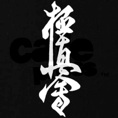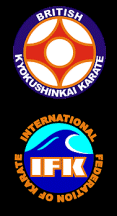Kyokushin Karate


The founder of our system, Masutatsu Oyama was born in 1923 near Seoul in South Korea. He studied Chinese Kempo at 9 years or age. When he was 12, he went to Japan to live and enrolled at University.
After mastering Judo, he became a pupil of Gichin Funakoshi himself making such rapid progress that at 17 he was 2nd Dan and at 24 became 4th Dan.
Deciding that he wanted to devote the rest of his life to spreading the knowledge of Karate, he spent the next year in seclusion from human society, living in temples and in the mountains; subjecting himself to the physical rigours of martial arts training day and night and meditating on Zen precepts, seeking enlightenment.
In 1951 he returned to civilisation and started his own training hall in Tokyo.
Since the foundation of the British Karate Kyokushinkai in 1965 we have seen a steady progression in both size and ability of one of the most respected Karate Organisations in Britain. One major reason for this progression lies in the personality and drive of it’s Chief Instructor Hanshi Steve Arneil (10th Dan). His depth of knowledge and tireless efforts have developed the unity of the British Karate Kyokushinkai.
Hanshi Arneil spent many years travelling the world, his journey culminating in Japan where he spent many years expanding his knowledge of the Martial Arts. He was also very instrumental in the British Karate scene in the 1970’s - where amongst other things he was coach of the successful British Squad that defeated Japan at the World Tournament.

Kyokushin Karate started in London when Steve Arneil and Bob Boulton returned to Great Britain after four years of study at the Kvokushinkai Honbu in Tokyo. The first Kyokushinkai Dojo was the London Karate Kai and this club was soon to become the premier club of Great Britain. In 1965 they founded the British Karate Kyokushinkai.
Within two years the British Karate Kyokushinkai had over 17 students who had qualified as British International Representatives. Steve Arneil became the British and English Team Manager / Coach and when the British Karate Team won the World Championship (the first country outside Japan to do so), he won the award for the World’s Best Coach. The British Karate Kyokushinkai now has over 80 Dojos in Great Britain and in 1978 staged the largest Karate Tournament ever to be held in Great Britain at Wembley Stadium. Kyokushinkai is now known for its high standard of Knockdown Tournament fighting which is based on full contact. However, the British Karate Kyokushinkai also competes in Kata Tournaments, WUKO Tournaments and Clicker style Tournaments (which are a Kyokushinkai innovation).
The British Karate Kyokushinkai is a founder member of the International Federation of Karate and through this organisation will continue to take part in world events with like minded Kyokushin Karateka.
The Grading Syllabus is one of the world’s most comprehensive and is administered and controlled in Britain by a highly qualified Board of Examiners.

The Kanji (Japanese Characters), often refered to as the caligraphy, worn universally on the front of the Gi (Karate Suit), simply means "Kyokushinkai", which is the name given by Sosai Mas Oyama to the karate style he created. "Kyoku" means "ultimate", "Shin" means "truth" or "realilty", "Kai" means "society" or "association".

The symbol of Kyokushin Karate is the "Kanku", which is derived from Kanku Dai kata, the Sky Gazing form. In this kata, the hands are raised and the fingers meet to form an opening through which the sky is viewed. The top and bottom points of the Kanku represent the first fingers of each hand touching at the top and the thumbs touching at the bottom, symbolising the peaks or ultimate points. The thick sections at the sides represent the wrists, symbolising power. The centre circle represents the opening between the hands through which the sky is viewed, symbolising infinite depth. The whole Kanku is enclosed by a circle, symbolising continuity and circular action.
The International Federation of Karate logo, worn at the top of the right sleeve of the Gi, has as its central symbol a rising wave, which is taken from Saiha Kata. This wave symbolises the fact that no matter how great an obstacle or problem you may encounter, with patience, determination and perseverance you can rise above and overcome it. The BKK have used the above Kanku and adapted it to is own symbol. The Kanku is in the middle. This BKK symbol is worn at the top of the left sleeve of the Gi.